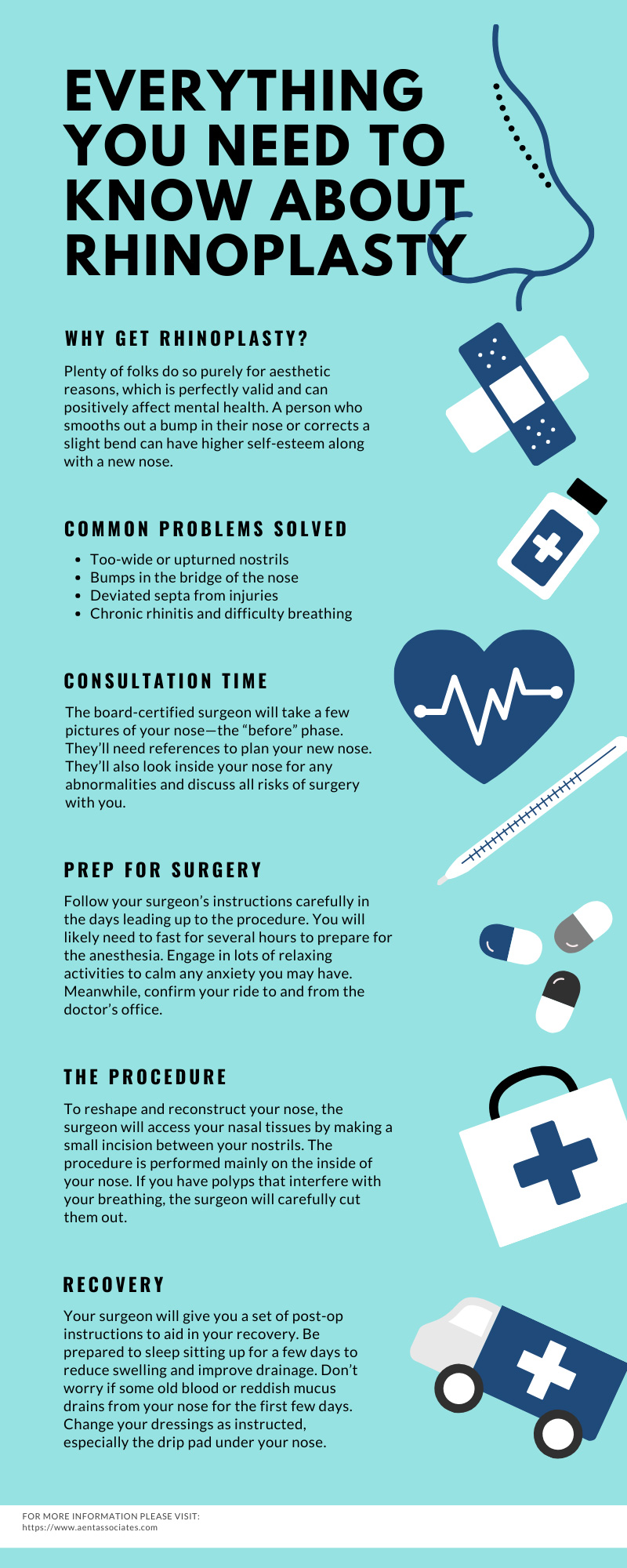
Do you know anybody who has had a rhinoplasty? People undergo this surgery for any number of reasons, from aesthetics to breathing quality. There are plenty of health benefits to adjusting one’s nose!
Rhinoplasty, commonly known as a nose job, reshapes the nose to fit an aesthetic or correct a deviated septum. The surgeon will work with the cartilage and soft tissue in your nose. It can be a life-changing procedure, one that doesn’t take eons to heal! If you decide that rhinoplasty is the right option for you, put your trust in the best allergists and sinus specialists near you.
If you’re still unsure about the process or how you’ll feel about the end results, read on. Learn everything you need to know about rhinoplasty to make an informed decision about your health.
Why Get Rhinoplasty?
Why do people get nose jobs in the first place?
Plenty of folks do so purely for aesthetic reasons, which is perfectly valid and can positively affect mental health. A person who smooths out a bump in their nose or corrects a slight bend can have higher self-esteem along with a new nose. People who have undergone rhinoplasty for cosmetic reasons also report improved social lives. Some even find more success at their job when they put their best face forward!
Some people also undergo rhinoplasty for the sake of their physical health. If you were pelted with a dodgeball as a kid and are now walking around with a deviated septum, that old injury can impact your breathing. One purpose of rhinoplasty is to straighten out the nose and help air flow more easily. Occasionally, parents will opt to get their child a nose job if an injury affects the way they breathe.
Common Problems Solved
Though we’ve already talked about a couple of issues that rhinoplasty can correct, let’s look at the range of issues that rhinoplasty can solve.
- Too-wide or upturned nostrils
- Bumps in the bridge of the nose
- Deviated septa from injuries
- Chronic rhinitis and difficulty breathing
- Birth defects (children born with cleft palates often undergo this surgery)
- Nasal polyps that clog airways
- Chronic low self-esteem due to teasing or bullying
Next time you seek sinus treatment in Houston, talk to your doctor about rhinoplasty. If you are dealing with any of the above conditions, a nose job could be the choice for you.
The Process
Let’s look at what actually happens if you decide to undergo rhinoplasty.
Consultation Time
Your rhinoplasty journey begins by simply talking to your doctor. Look up a sinus specialist near you and ask about plastic surgeons they may have on staff. When you walk into your scheduled consultation, your doctor will ask you about your goals. What do you hope to achieve with rhinoplasty? Are you looking to undergo the surgery for cosmetic reasons, physical health-related reasons, or both?
The board-certified surgeon will take a few pictures of your nose—the “before” phase. They’ll need references to plan your new nose. They’ll also look inside your nose for any abnormalities and discuss all risks of surgery with you.
They may also offer a book or pamphlet of noses so that you can shop around, so to speak. You’ll be able to point to a nose shape and say, “That’s the one I want.”
Prep for Surgery
In the month leading up to your rhinoplasty surgery, your doctor will likely advise you to refrain from smoking, drinking alcohol, or consuming caffeine. Avoid aspirin as well.
A week before your surgery, start arranging your surroundings at home for a cozy recovery. Build a space where you’d be comfortable spending the majority of your time for up to a week. Do everything you can to create a convenient space stocked with medical supplies, healthy snacks, and things to occupy your time, such as games or movies. You won’t want to do any of this after your surgery—you’ll be exhausted!
Follow your surgeon’s instructions carefully in the days leading up to the procedure. You will likely need to fast for several hours to prepare for the anesthesia. Engage in lots of relaxing activities to calm any anxiety you may have. Meanwhile, confirm your ride to and from the doctor’s office.
The Procedure
Rhinoplasty is often done within one or two hours as an outpatient procedure, meaning you won’t need to stay in the hospital to recover. If you do opt for a rhinoplasty surgery, your doctor will discuss anesthesia options with you. You can go for either a local anesthetic (your face will be numb, but you’ll be awake) or general anesthesia (you’ll be unconscious for the whole procedure).
To reshape and reconstruct your nose, the surgeon will access your nasal tissues by making a small incision between your nostrils. The procedure is performed mainly on the inside of your nose. If you have polyps that interfere with your breathing, the surgeon will carefully cut them out.
Depending on the nature of your unique case, your surgeon may take cartilage from another part of your body, like your ear, to reconstruct your nose. However, this is not always the case.
Once your surgeon has finished the reconstruction, they will carefully put your skin and tissues back in place. They’ll stitch up the initial incision between your nostrils, and you’re done! The next step is waking up.
Recovery
Once your rhinoplasty procedure is finished, the medical staff will move you to a recovery room, where they will monitor you as you wake up. Once you’re fully awake, your ride can take you home and ease into that recovery nest you made beforehand.
Your surgeon will give you a set of post-op instructions to aid in your recovery. Be prepared to sleep sitting up for a few days to reduce swelling and improve drainage. Don’t worry if some old blood or reddish mucus drains from your nose for the first few days. Change your dressings as instructed, especially the drip pad under your nose.
For the first few weeks after your surgery, avoid strenuous activity or exercise. Take baths instead of showers to keep your dressings dry. Don’t blow your nose for a while, and eat foods high in fiber to avoid constipation.
Just sit back and relax for the first week, letting the swelling subside and the extra fluid drain. Within a few weeks, your new nose will be healed and ready to show the world!
If you’re weighing whether rhinoplasty is the right choice for you, keep this guide on hand to give you an idea of how the process looks. Allergy & ENT Associates is home to a team of experienced and empathetic surgeons who specialize in nasal surgery. Now that you understand everything you need to know about rhinoplasty, you can talk to your doctor today about your options.




